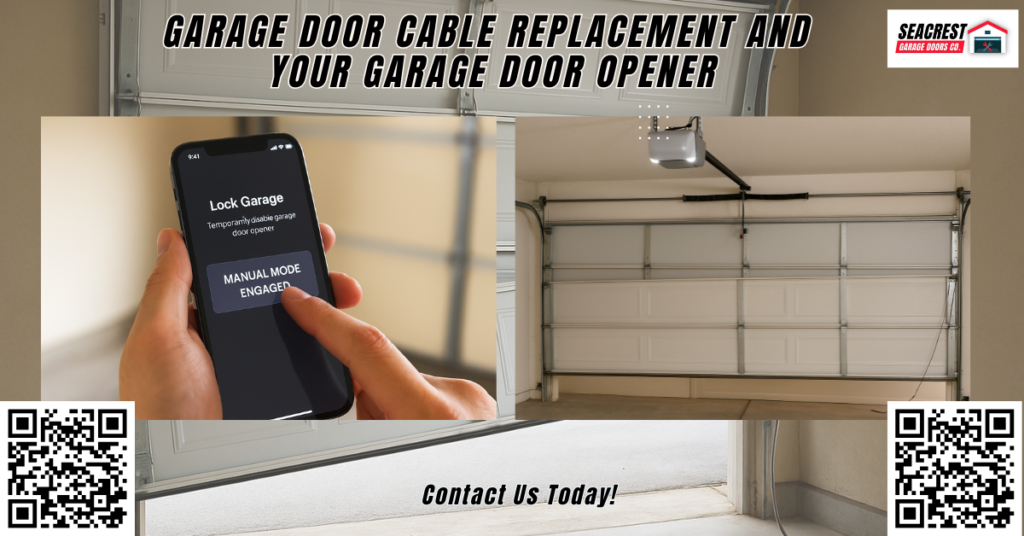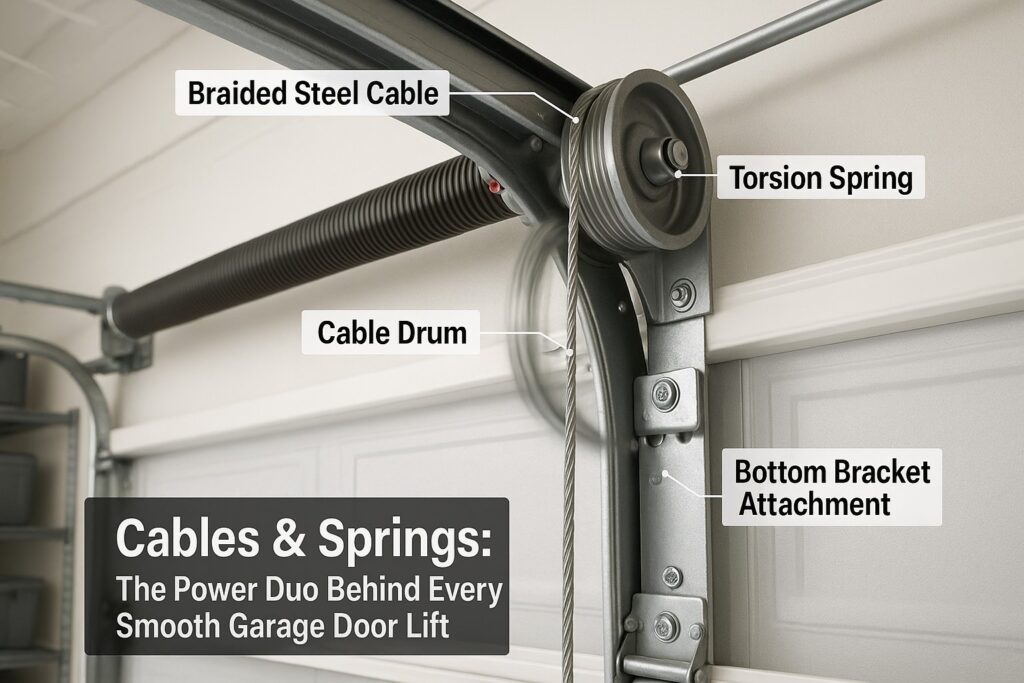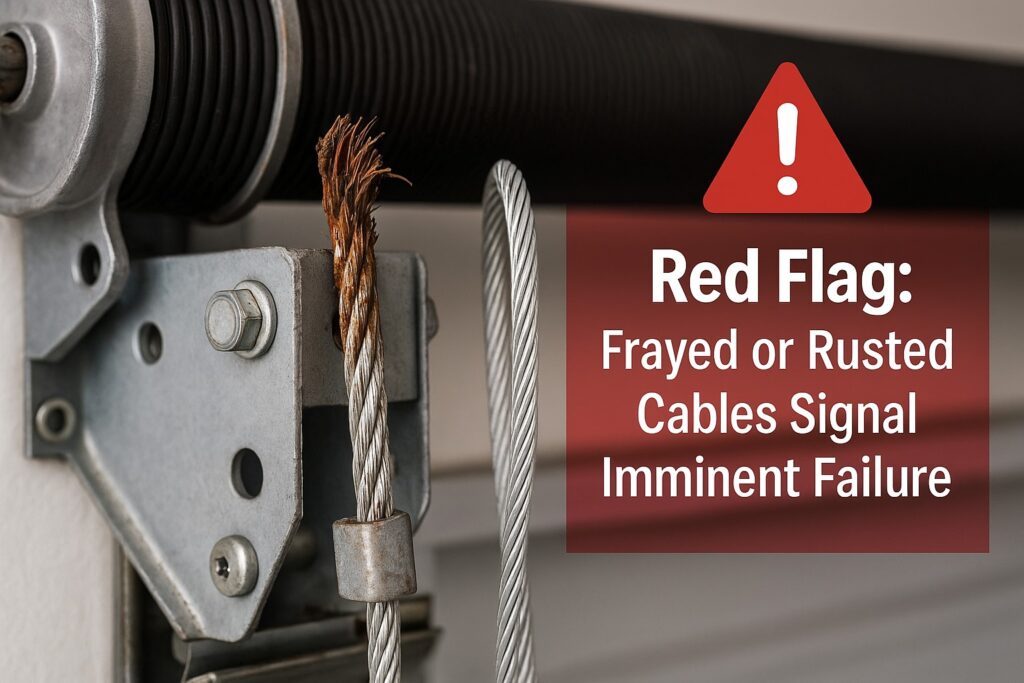Garage Door Cable Replacement and Your Garage Door Opener

Larry from Lincoln, NE, was getting ready to leave for work when he hit the button on his garage door opener. The door started to rise, but then suddenly dropped with a loud bang. His garage door had become uneven, the opener made grinding noises, and the door wouldn’t budge. What happened? A broken garage door cable had thrown the entire system out of balance, and now the garage door opener was struggling to function. This is a common scenario that shows just how important cable replacement is to the overall health of your garage door system.
According to the National Electronic Injury Surveillance System (NEISS), over 20,000 garage door-related injuries occur annually in the United States. Many of these incidents involve broken cables, faulty garage door springs, or malfunctioning garage door openers. These essential parts work together to ensure the smooth, safe operation of your garage door. When one fails, it can lead to further damage, costly repairs, and serious safety risks.
At Seacrest Garage Doors Co., we specialize in garage door cable replacement and understand how deeply connected your garage door cables are to the reliable function of your garage door opener. In this comprehensive guide, we’ll cover everything you need to know about garage door cables, how they relate to your opener, and what steps you should take to maintain a safe and efficient system for your home and family.
Understanding Garage Door Cables: Their Purpose and Importance
Garage door cables are a vital component of the garage door system. These high-tension cables are responsible for lifting and lowering the garage door in coordination with the springs, whether torsion or extension types. Without functional door cables, your garage door would not operate safely or efficiently.
Key Parts Involved:
- Garage Door Springs (Torsion or Extension): Help offset the heavy weight of the door.
- Cable Drums: Located at the top of the door on either side, the cables wrap around these drums during door operation.
- Bottom Brackets: Secure the cables to the lower portion of the garage door.
- Pulley System: Common in extension spring systems, the pulleys guide the cables as the door moves.
- Torsion Tube: Works with the torsion springs to transfer force through the cables for smooth lifting.

As the garage door operates, cables wrap or unwind from the drum, keeping tension constant and the door balanced. A broken cable can throw off this balance, damaging the torsion tube, springs, or opener. In addition, poorly functioning cables can put your family at risk, potentially allowing a heavy door to slam shut unexpectedly.
Garage doors weigh between 130 to over 400 pounds, and garage door cables help manage this weight. When working correctly, the system operates with minimal effort. But when cables corrode, wear, or snap, the full weight of the door can shift unexpectedly, leading to structural damage, personal injury, or mechanical breakdown of the opener.
Why Garage Door Cables Break Over Time
Garage door cables are strong, but they are not indestructible. Like any part exposed to stress, tension, and environmental elements, they eventually wear out. Cable failure can happen suddenly, often when you least expect it.
Common Causes of Broken Garage Door Cables:
- Rust and Corrosion: Moisture causes cables to corrode over time. Rust weakens the wire strands, making them brittle and more prone to snapping. In humid climates or uninsulated garages, corrosion occurs faster, especially in areas like Lincoln, NE, where winter road salt can accelerate deterioration.
- Wear and Tear: Friction from regular use slowly frays the cable, especially if it rubs against metal edges or a misaligned pulley. Without proper lubrication and alignment, cable wear becomes uneven, creating weak spots.
- Lack of Maintenance: Skipping routine maintenance like inspections and lubrication causes cables and other parts to degrade more quickly. Dirt and debris buildup in the pulley system also leads to extra strain.
- Old Cables: Even without visible damage, old cables lose integrity after years of use. Most cables last 7–12 years, depending on usage, climate, and the quality of the materials.
- Improper Tensioning: If the cable was installed incorrectly or tensioned poorly, it may wear unevenly and fail sooner. Tension must be adjusted based on the garage door’s weight and spring type to maintain system harmony.
- Broken or Loose Bottom Brackets: If the brackets become damaged or loosen over time, they can place extra stress on the cable or allow it to slip from position.
Regular inspections can help catch these issues early. Replacing worn cables proactively is far less expensive than dealing with a damaged opener or a fallen door.
Connection Between Cables and Garage Door Openers
Your garage door opener is a powerful tool, but it depends heavily on the rest of the garage door system to work properly. Garage door cables and springs lift most of the door’s weight, while the opener simply guides the movement.
How Cable Issues Affect Garage Door Openers:
- Strain on the Motor: Without proper spring tension and cable balance, the opener does more lifting, wears out gears, and burns out the motor. Replacing an opener due to cable failure is a costly consequence of skipped maintenance.
- Uneven Operation: One broken cable causes the door to lift unevenly, potentially jamming or damaging the tracks. This misalignment can cause the door to become stuck, crack panels, or warp the frame.
- Sensor Errors: Many smart garage door openers have sensors that detect resistance or imbalance, causing them to shut down prematurely. These sensors may interpret the unbalanced load as an obstruction.
- Further Damage: A damaged cable can cause jerky movement, slamming doors, and even cause the opener’s belt or chain to break. This chain reaction of damage increases the need for more intensive repairs.
Garage door openers are engineered to work with a balanced, smooth-running door system. Cable replacement restores this balance, reducing stress on the motor and extending its lifespan.
Signs You Need Garage Door Cable Replacement
Identifying issues early can save your garage door system from further damage. Here are warning signs that your cables are on their last legs:
- Visible Fraying or Rust: Inspect the cable along the sides of the door. Frayed or rusted cables should be replaced immediately. Use a flashlight and gloves to check for sharp or thin spots.
- Slack in the Cable: If the cables appear loose or hanging, they may have slipped off the drum or snapped. In either case, this is a major safety issue and should be addressed promptly.
- Uneven Garage Door: A door that looks crooked or gets stuck halfway often indicates that one cable is damaged. Continuing to operate it can worsen the damage or cause it to jam entirely.
- Strange Noises: Snapping, grinding, or popping sounds during operation suggest tension or cable issues. These sounds may also come from the pulley system or garage door springs.
- Opener Malfunctioning: If the opener struggles, it could be compensating for a broken cable. You might notice it working harder, making unusual noises, or failing to fully open or close the door.

Addressing these signs early can prevent further problems. Don’t wait for complete failure, proactive garage door cable replacement is safer and more cost-effective.
Why You Should Never DIY Cable Replacement
While it might be tempting to treat garage door cable replacement as a DIY home repair, the task is far more dangerous than it appears.
Hazards of DIY Cable Replacement:
- Extreme Tension: Garage door springs and cables are under high tension. Releasing or adjusting them incorrectly can cause serious injuries. Torsion springs especially store a tremendous amount of energy.
- Lack of Proper Tools: Specialized tools are needed to safely wind and unwind torsion springs, set cable drums, and balance spring tension. Attempting the repair with makeshift tools often leads to mistakes.
- Improper Repairs: Even if you install new cables, without adjusting other parts like the springs or pulleys, your door may still not operate correctly. Balance, alignment, and safety systems must all work together.
- No Safety Gear: Without personal protective equipment (PPE) such as gloves and safety glasses, you risk cuts, bruises, or worse. Winding bars, safety glasses, and lockout tools are essential for this task.
- Risk of Further Damage: Incorrect installation may lead to further damage to the door, tracks, or opener, resulting in higher repair bills.
For the sake of safety and your home’s long-term maintenance, garage door cable replacement should always be handled by professionals with the right experience and equipment.
Step-by-Step Guide: What a Professional Does During Cable Replacement
At Seacrest Garage Doors Co., our process is designed to be thorough, safe, and effective. Here’s how we approach every garage door cable replacement job:
- Inspection and Diagnosis: We inspect cables, garage door springs, rollers, pulleys, and the opener for damage. A complete assessment helps uncover any hidden issues.
- Safety Precautions: We disconnect the opener, wear PPE, and release spring tension using the right tools. We ensure the area is secure before beginning work.
- Removing the Old Cables: We carefully remove the old cable from the bottom bracket and unwind it from the cable drum. This requires attention to prevent snapping or backlash.
- Installing New Cables: We install high-quality, rust-resistant cables and attach them securely. The new cables are tension-matched to the spring system.
- Adjusting Spring Tension: Re-tensioning the torsion or extension springs ensures proper balance. Accurate spring tension is key to safe operation.
- Testing the System: We manually lift the door to check balance and smooth operation. We check for correct alignment and tension.
- Opener Reconnection and Test: We re-engage the opener and test its movement with the new cable system. This ensures the entire garage door system functions as it should.
This professional process guarantees not only safe installation but also long-term reliability.
Preventive Maintenance Tips for Homeowners
Keeping your garage door system in top shape helps avoid sudden repairs and accidents. Here are some easy maintenance tasks you can perform:
- Inspect Regularly: Every month, check for signs of fraying, rust, or loose parts. Look over rollers, hinges, brackets, and springs.
- Listen to Your Door: Grinding or squeaking sounds usually indicate friction or tension issues. Sounds can pinpoint specific failing parts.
- Lubricate Moving Parts: Use a garage door lubricant on hinges, pulleys, springs, and tracks every few months. Avoid household oils like WD-40.
- Check Door Balance: Disconnect the opener and lift the door manually. If it doesn’t stay halfway up, it’s out of balance. This could be a sign of failing springs or misaligned cables.
- Call for Annual Inspections: Have a professional inspect the full system yearly, including garage door tension and opener performance. They can spot problems before they become emergencies.
Preventive maintenance improves the lifespan of all garage door parts and helps avoid emergency service calls.
Final Thoughts: Protect Your Home and Family
Your garage door system is a complex and heavy-duty mechanism that plays a vital role in your home’s security, safety, and convenience. A single broken cable can set off a cascade of problems, from misaligned tracks to burned-out openers and dangerous accidents. That’s why garage door cable replacement should never be overlooked.
At Seacrest Garage Doors Co., we’re committed to helping families across Lincoln, NE, maintain their garage doors in peak condition. Whether you’re facing urgent repairs or want to take preventive steps with regular inspections and professional service, we’re here to ensure everything runs smoothly and safely.
Remember: a properly maintained garage door system isn’t just about convenience, it’s about safety, efficiency, and protecting the investment you’ve made in your home.
How Can Seacrest Garage Doors Co. Help You?
Whether you’re dealing with a broken garage door, a noisy opener, or simply want preventive maintenance, Seacrest Garage Doors Co. is here to help. We proudly serve Lincoln, NE, and surrounding areas with expert garage door services, including garage door cable replacement, garage door repair, opener maintenance, and full system upgrades.
Why Choose Us?
- Experienced, licensed technicians
- Fast, friendly, and reliable service
- Quality replacement parts and tools
- Same-day emergency repairs available
- Affordable pricing with no hidden fees
Call us today at (402) 374-9880 or book online HERE, or stop by our office at 6891 A St #104, Lincoln, NE 68510 to schedule your service. Trust Seacrest Garage Doors Co. to keep your garage door system running safely, smoothly, and efficiently every time you hit that opener button.
Frequently Asked Questions (FAQs)
Q1: Can a garage door function with just one cable working?
No, operating your garage door with only one functional cable is unsafe and can cause the door to become unbalanced and fall, leading to serious damage or injury.
Q2: What type of cable is best for garage door replacement?
Aircraft-grade galvanized steel cables are preferred due to their strength, resistance to corrosion, and durability under high tension.
Q3: Will replacing cables affect my garage door opener settings?
Yes, after cable replacement, your opener may need recalibration or resetting to ensure proper function with the newly balanced door system.
Q4: Can I still open my garage door manually if the cables are broken?
You should not attempt to open the door manually with broken cables, as it can be extremely heavy and dangerous without proper counterbalance support.
